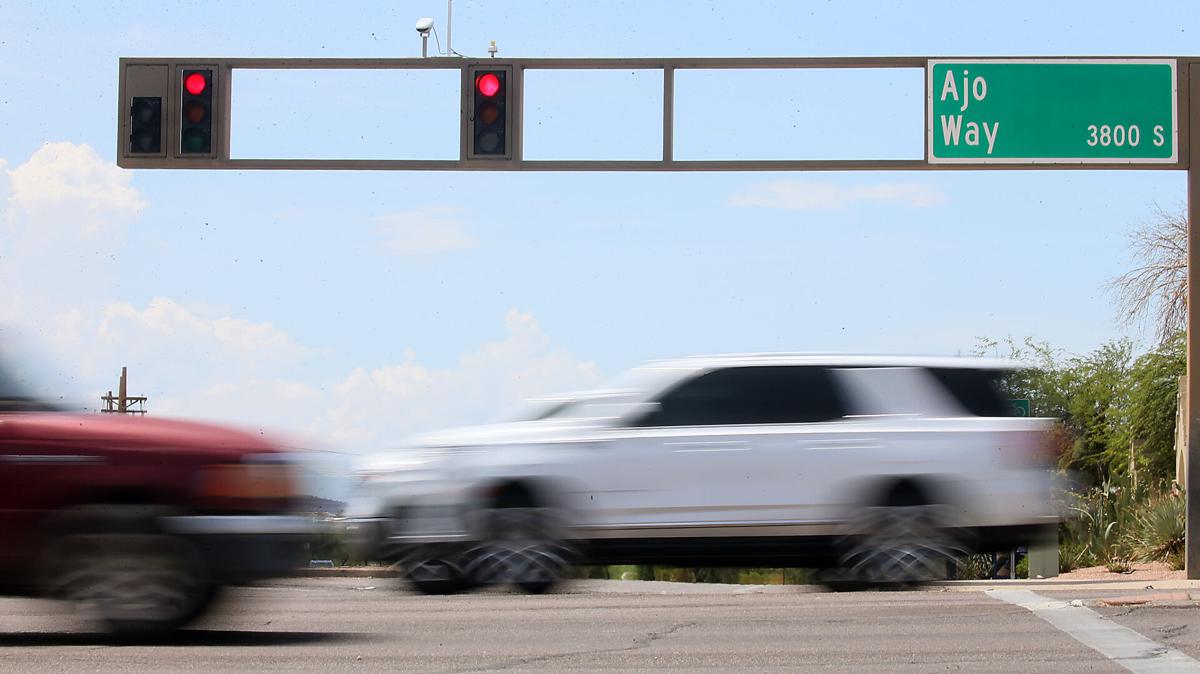Testing is underway to see if updated traffic signal technology will lead to smoother commutes in Tucson.
The Tucson Department of Transportation and Mobility launched the yearlong pilot program this month, installing Adaptive Signalization Control Technology in corridors such as Ajo Way between South Mission Road to South Park Avenue as well as South 12th Avenue between West Irvington and Drexel roads.
“The city is looking for new technologies to be able to move traffic around Tucson in a more efficient way, and adaptive (signals) are one of the latest technologies that can help move traffic in cities more efficiently,” said Francisco Leyva, a traffic engineering project manager with the department.
The department said the technology works by collecting data using strategically placed sensors to evaluate how the signal is performing. The data is evaluated, and changes can be made to the signal timing to adapt to real-time traffic conditions.
The corridors selected for testing provide different high-volume environments to see how the system could help improve traffic flows.
“The Campbell and the Park corridors are kind of typical arterial intersections and roads. We want to see what effect we have with that, knowing adaptive systems for a local street is not the right technology,” Leyva said.
The Ajo Way route provides an environment where the street intersects with Interstate 19 and further west becomes a state highway.
“With those two types of interactions, how is the adaptive system going to be helpful with arterial systems when you interface with an interchange to an interstate and a state highway when Ajo has a lot of volume?” Leyva said.
He added it could help solve one of Tucson’s lasting problems.
“One of the issues that Tucson’s always had is no freeways for the east-west corridors. We’re trying to fit more vehicles in our roads, and we cannot physically grow the roads,” Leyva said. “We’re looking to move vehicles more smartly and have them traverse the city in less time.”
The department said the adaptive signal system has been known to: continuously distribute green light time for all traffic movements; reduce traffic delay and congestion by creating smoother flow; improve travel time reliability; decrease idling time to reduce wear and tear on roads; and decrease vehicle emissions.
The system also could aid the department in retiming signals with less effort, cutting down the current weeklong timeframe to collect traffic volume data and have engineers make corrections.
“When you’re out there, you can see if somebody starts going really fast when they get a green (light), they usually arrive at a red and they stop. Then it takes some time to get started again. So that creates a backup itself,” Leyva said.
“If you have vehicles going at a slower speed, but you can coordinate the signals correctly, you can move them through several signals instead of just having accelerations and stopping at the next signal.”
Down the road South Houghton widening has started
The Pima County Department of Transportation, along with its contractor, Borderland Construction, has begun a $30 million project to widen and improve about three miles of South Houghton Road from the Interstate 10 interchange to Andrada Polytechnic High School, 12960 S. Houghton.
The work, which began last week, is being done from 6 a.m. to 3 p.m. weekdays. Traffic will remain in the current configuration while the contractor builds the new southbound lanes, west of the roadway, along with the drainage improvements.
Improvements will include widening of Houghton from a two-lane roadway to a divided four-lane roadway, a separated multi-use path that will connect to the loop, drainage and intersection improvements. The project is expected to be completed in late 2022 or early 2023.
For more information on the project, visit www.roadprojects.pima.gov
Lane restrictions on I-10 at Ruthrauff
Motorists on westbound Interstate 10 near Ruthrauff Road should expect overnight lane restrictions Monday, July 26.
Westbound I-10 will be reduced to one lane between 8 p.m. and 5 a.m. Tuesday. Ramps will remain open.
Drivers should proceed through the work zone with caution, slow down and watch for construction personnel and equipment.
More information about the project to reconstruct the interchange of I-10 and Ruthrauff Road is available at azdot.gov/RuthrauffTI.
A black bear caught on a wildlife camera in the Catalina Mountains stopped by a watering hole near Tucson for a quick drink and a bath July 14.
Video courtesy Greg Joder @_eco.nut_ on Instagram.








